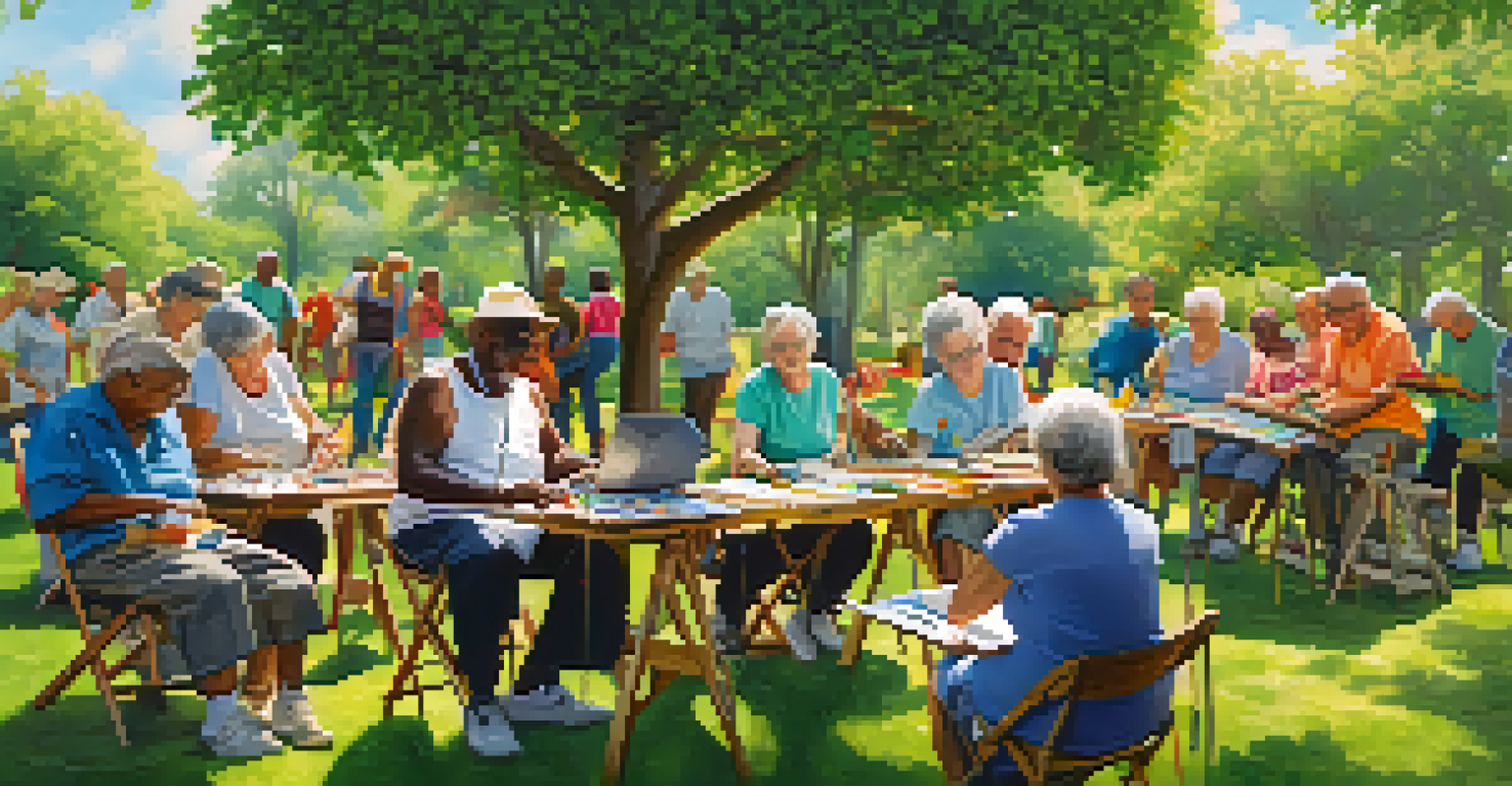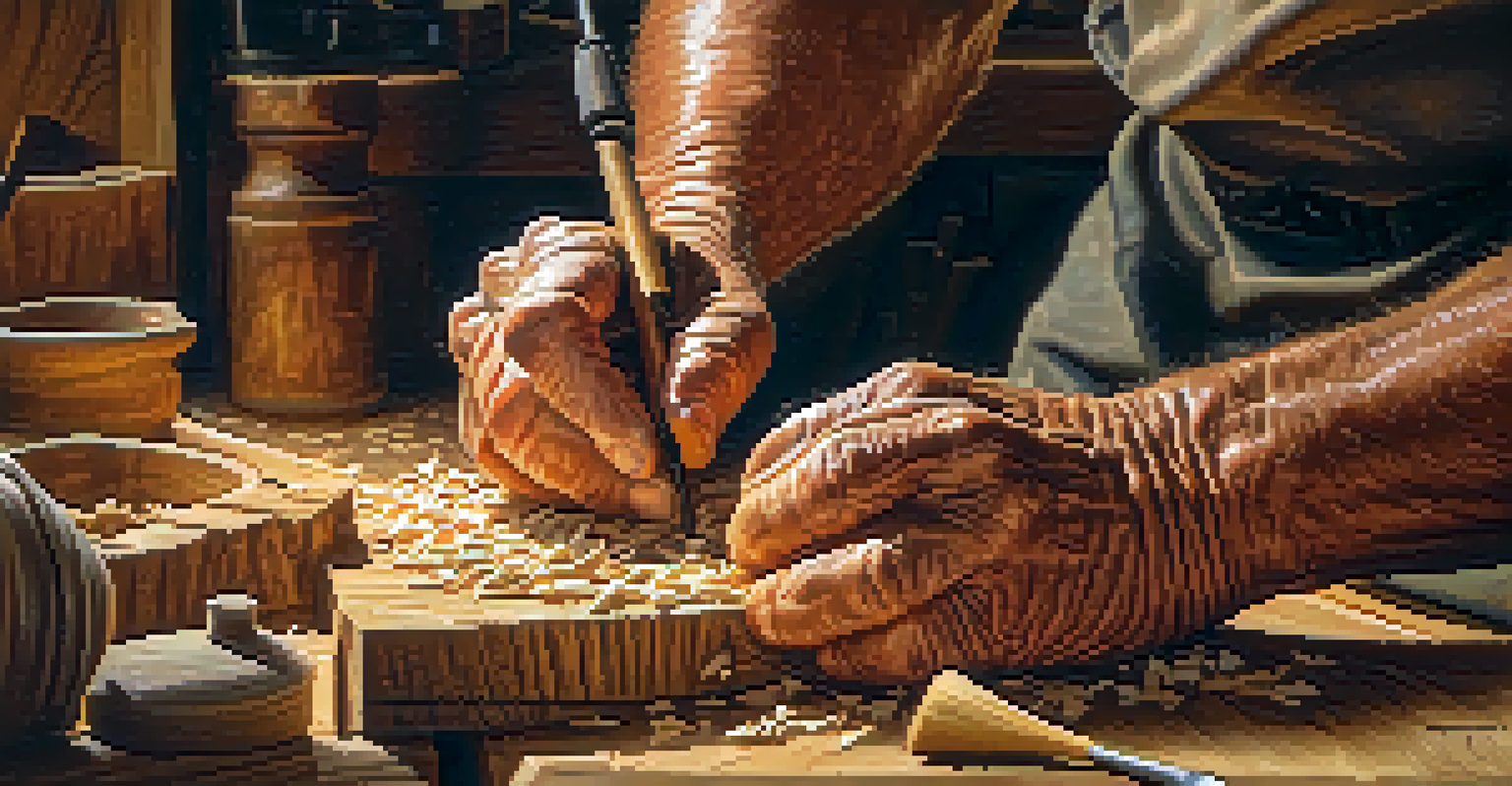Art and Aging: The Influence of Culture on Expression

Understanding Art's Role in Aging and Culture
As we age, art becomes a vital form of self-expression, providing a canvas for our thoughts and emotions. It helps to communicate experiences that words sometimes fail to capture. Different cultures influence how we perceive and create art, adding layers of meaning to our expressions. Whether through painting, music, or dance, art allows seniors to share their unique stories while connecting with others.
Art is the most beautiful of all lies.
The cultural context in which we grow up shapes our artistic preferences and methods. For instance, someone raised in a vibrant, music-rich environment may find solace in rhythm and melody as they age. In contrast, another person from a more visual culture might gravitate toward painting or sculpture. These influences not only dictate the medium but also the themes and messages conveyed in their artwork.
Moreover, art serves as a bridge between generations, fostering understanding and appreciation for diverse cultures. By sharing artistic practices, seniors can pass down traditional forms of expression, ensuring that their cultural heritage remains alive. This exchange enriches the community and creates a sense of belonging, reminding us that creativity has no age limit.
Cultural Influences on Artistic Expression in Seniors
Cultural backgrounds significantly shape how seniors express themselves artistically. For example, in Indigenous cultures, storytelling through art is a time-honored tradition that allows elders to share wisdom with younger generations. This practice not only preserves cultural narratives but also empowers seniors to reclaim their voices and identities through art.

In many Asian cultures, the concept of respect for elders is deeply rooted. This reverence often encourages older individuals to engage in art forms that emphasize harmony and balance, such as calligraphy or traditional dance. These art forms not only foster creativity but also reinforce the values of their culture, creating a meaningful outlet for expression.
Art Enhances Senior Well-Being
Engaging in artistic activities boosts mental health and fosters social connections among seniors.
Conversely, in Western cultures, there tends to be a stronger emphasis on individualism. This perspective encourages seniors to explore personal narratives in their artwork, often leading to more abstract or experimental forms of expression. By embracing their unique life experiences, seniors can challenge societal norms and redefine what it means to grow older in a modern context.
The Therapeutic Benefits of Art in Aging
Engaging in art can offer therapeutic benefits for seniors, positively impacting mental health and overall well-being. Creating art allows for emotional release and can serve as a coping mechanism for dealing with loss or loneliness. Activities like painting or crafting provide a structured way for seniors to focus their thoughts and feelings, transforming them into something tangible.
Every artist dips his brush in his own soul, and paints his own nature into his pictures.
Research has shown that artistic endeavors can boost cognitive function, enhancing memory and problem-solving skills. This mental engagement is particularly beneficial for seniors as they navigate the challenges of aging, such as the onset of dementia or other cognitive impairments. By keeping the mind active through creativity, seniors can maintain a sense of purpose and self-worth.
Additionally, art can foster social interaction and community involvement. Participating in group art classes or workshops allows seniors to connect with others, combatting isolation and loneliness. These social bonds formed through shared creativity can significantly improve emotional health and contribute to a more fulfilling life.
Art as a Reflection of Aging Experiences
For many seniors, their artwork serves as a reflection of their life experiences. Each piece can encapsulate memories, emotions, and milestones, acting as a visual autobiography. This artistic expression not only preserves their legacy but also encourages introspection and self-discovery in the process of creation.
Art can also challenge societal perceptions of aging, showcasing the vibrancy and diversity of older adults. By portraying their realities, seniors can dismantle stereotypes associated with aging, inviting viewers to appreciate the richness of their experiences. These authentic representations foster empathy and understanding across generations.
Cultural Context Shapes Expression
Seniors' artistic expressions are significantly influenced by their cultural backgrounds, impacting their preferred mediums and themes.
Furthermore, the process of creating art can help seniors process and make sense of their life transitions. Whether it’s the loss of loved ones, changes in health, or shifts in identity, art offers a powerful medium for exploration and healing. In this way, creativity becomes not just a form of expression but also a pathway to resilience.
Cultural Events and Community Engagement in Art
Cultural events play a pivotal role in showcasing the artistic talents of seniors. Festivals, exhibitions, and community art projects provide platforms for older adults to share their work and engage with the public. Such opportunities not only validate their creativity but also foster a sense of belonging and pride within the community.
These events often celebrate the rich tapestry of cultural backgrounds, allowing seniors to connect with others who share similar experiences or interests. By participating in these gatherings, seniors can learn from one another, exchange ideas, and inspire one another’s artistic journeys. The sense of camaraderie built through these events can be incredibly uplifting.
Moreover, community engagement through art can promote intergenerational dialogue, bridging the gap between young and old. When seniors share their artistic practices with younger generations, it cultivates mutual respect and understanding. This collaborative spirit enriches both groups, ensuring the continuity of cultural traditions while fostering innovation.
The Role of Technology in Senior Artistic Expression
In today's digital age, technology has opened up new avenues for artistic expression among seniors. Online platforms and social media allow older adults to share their artwork with a global audience, breaking down traditional barriers to visibility. This accessibility empowers seniors to showcase their creativity and connect with fellow artists, regardless of geographical limitations.
Moreover, technology can enhance the creative process itself. Digital tools and software enable seniors to experiment with different mediums and styles, often leading to innovative outcomes. Virtual art classes and workshops provide opportunities for learning and skill development, making art more approachable and enjoyable for those who may feel intimidated by traditional methods.
Diversity Enriches Artistic Landscape
Celebrating the diverse artistic voices of seniors promotes inclusivity and challenges stereotypes about aging.
Importantly, technology can also serve as a means for emotional connection. Through virtual galleries and online communities, seniors can engage with others who share similar interests, fostering relationships that transcend physical distance. This aspect of technology not only enriches their artistic experiences but also combats feelings of isolation.
Celebrating Diversity in Senior Artistic Expression
The diversity of artistic expression among seniors is a testament to the rich cultural tapestry of our society. Each individual brings their unique perspectives, experiences, and backgrounds into their artwork, creating a vibrant mosaic of creativity. This diversity enriches the cultural landscape and allows for a broader understanding of the aging experience.
Celebrating this diversity is essential in promoting inclusivity and representation in the arts. By highlighting the work of seniors from various cultural backgrounds, we can challenge the mainstream narratives that often overlook their contributions. This recognition not only validates their creativity but also inspires future generations to embrace their own artistic identities.

Ultimately, the celebration of diverse artistic expressions among seniors fosters a culture of appreciation and respect. It encourages open dialogue about the complexities of aging while showcasing the beauty and resilience of older adults. By championing diversity in art, we can create a more inclusive society that values the voices of all individuals, regardless of age.